Here are the promised kestrel pictures.
All 5 of these kestrel chicks were from one nest. The building the nest was in was scheduled to be was burned for firefighter training. We were notified the evening before the fire and took them.
Day 1
The first photo was taken the first evening. The youngest had just hatched. It’s down was still damp from being in the egg. Kestrel eggs hatch out over a period of several days, in the sequence in which they are laid, so all the babies ages differ.
In this picture, the youngest chick is by itself in the upper left. At the top, slightly to the right of center, there is a little hand. That was lizard that the parents had taken to the nest for food. I minced it, and it became the kestrels first meal. After that, they had to settle for minced mice.
Day 2
At the tip of their beaks you can see a small white spot. That is called the egg tooth. It helps the chick break out of the shell. It disappears over time.
Day 3 to Day 7
One pic per day for the rest of the week
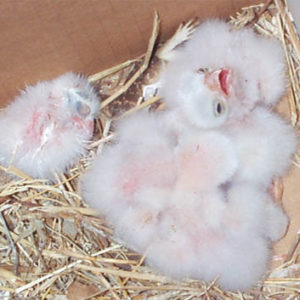
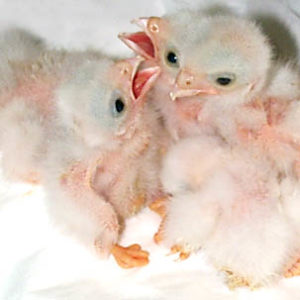
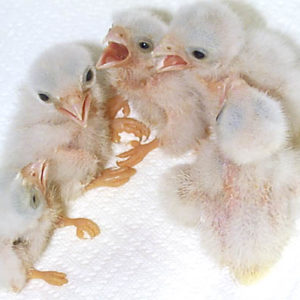
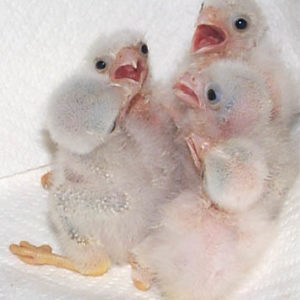
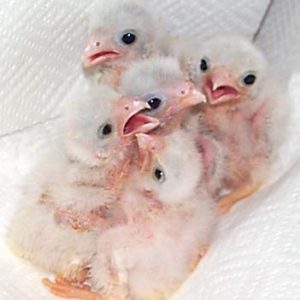
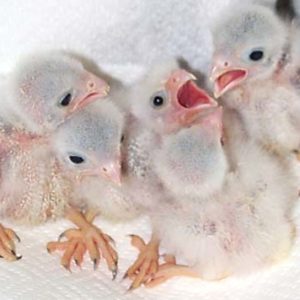
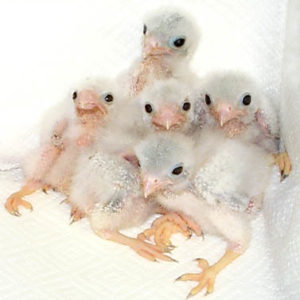



















Replies
One pic per day for Days 8 to 14
Days 15 to 19, and Day 21
Amazing! That is so cool. Thanks for the pics, it's great to watch their development. Just saw March of the Penquins, this reminds me of some of the chicks in the movie. Just barely. I think these guys would eat those guys, though, huh?
"I am the master of my fate, I am the captain of my soul." Invictus, by Henley.
Hi Nick
I'm sorry I missed seeing that. I don't think a kestrel could do much with a penguin. Kestrels are our smallest falcon. About the size of a blue jay or robin.
Day 28The last day of captivity.
Day 29The enclosure the kestrels were living in was opened to allow them to leave to explore their world. All of the babies left. Food was provided for them for as long as they needed it. The photo is of 3 returning to eat.
Day 31The two male kestrels returned to eat. The food is a domestically raised quail.
Day 31The two female kestrels returned to eat.
Day 31The third female kestrel returned to eat.
Last photo was also Day 31Little tufts of baby down are still visible. The kestrels continued eating from their board for several weeks, but the quantity they need declined quickly as they started finding their own food. I had pigeons at the time and it was a ball to watch them work on strategies to attack a pigeon with being seen till the last moment.
Very cool! Did u have to hand feed each one? How tall were they? Wing span? Are they found all over North America? Sorry if I'm asking the dumb questions but I find that interesting!
excellent... thanks..Life is not a journey to the grave with the intention of arriving safely in a pretty and well preserved body, but rather to skid in broadside, thoroughly used up, totally worn out, and loudly proclaiming<!----><!---->
WOW!!! What a Ride!<!---->
Forget the primal scream, just ROAR!!!
Glad you liked them.
The American Kestrel is a small bird. Adults are slightly under 12" in length. Their wingspan is about 22 inches. Birds are very light in weight and much of these measurements are just feather. The smallest chick in the first picture I posted was smaller than a quarter.
At first they did have to be hand fed. When feeding, the parents hold small bits of food in their beaks, gently nudge the chicks beak and let the baby take the food. As a substitute, we hold the bit of food with forceps and tap the chicks beak. It is critical to not let the chick see or hear people at that point or they will imprint on humans. We stay completely covered so they don't know what is giving the food. Within about a week the bigger chicks were feeding themselves, but we did chop the food and removed most of the mouse fur. As they grew, they became able to tear up their own food, and handle more indigestible fur. We let them start killing small mice before they were released, so they had that experience. They were released just before they could fly well, so that they would stay close and we could provide food while they were learning to hunt. Within 3 weeks of release they were taking very little of the food we offered.
It is extremely important for their diet be complete and include bone and all the organs of the prey animal, or severe damage from malnutrition can quickly develop.
They can be found in all of the continental US including Alaska. The most common place to spot the is perched on utility lines, hunting for mice or bugs on the ground. They can also be seen on buildings, as they like to nest in cavities. Being falcons, their silhouette in flight is quite distinctive, with pointed wings built for speed in flight.
No problem about questions. I'm glad your interested.
Terrific photos and thanks!
The plumage of Kestrels, Wood ducks and Harlequin ducks are among my favorites.
The plumage of Kestrels, Wood ducks and Harlequin ducks are among my favorites.
For beauty they're about the best. Owls however are incredibly soft.
Do you have any owl flight feather photos, magnified for detail?
Quite a marvel of "engineering.....natural stealth!
Not really magnified, but these Great Horned Owl feather were saved as a fairly big file.
The pic didn't go so try again.
What a resource you are! Thanks!
To the uninitiated, the "furry" edge on those flight feathers enable an owl to swoop down on his/her prey in silence. Compare that to the insect eating nighthawks whose dives are distinctly audible.
Our local recue center (I'll check to see if thay have a website) is pretty broad in their wildlife coverage; from young seals who well-meaning beach walkers find them alone and bring them in, thinking they've been abandoned, to deer fawns (same issue), to injured Ospreys, eagles and a variety of other raptors, to Great Blue Herons (probably the most dangerous bird to handle....full facial protection is mandatory....they're really quick and go for the eyes!).
""Great Blue Herons (probably the most dangerous bird to handle....full facial protection is mandatory....they're really quick and go for the eyes!).""
Wow! I would remember to stay away from them!
I've had been able to save several tangled in fishing line in the river. It's not too hard to help them out, but as Notchman said your protection is vital. I've been lucky using only safety glasses. And yes I have been zapped in the glasses - with no damage done. Once captured two people can easily restrain the bird and cut out the fishing line. Sometimes the line can get embedded pretty badly if the bird has been in it for a time, but a lot of them can be immediately let go.
If you have the chance, help one out, but protect your eyes and face.
Thank you - I'm glad I had the pic.
My roughest encounter was capturing a Cormorant. That guy was so fast, I have no idea how he did it, but the beak was something like a chainsaw. I was dripping blood. (Well, a little blood.) At least he went for the arms, not eyes, probably only because he didn't have the terrific neck of the GBH.
The most frequently kidnapped babies I received were owls. Young owls leave the nest well before they can fly. They scoot around on the tree branches, and are even called branchers at that stage. Naturally they also sometimes tumble to the ground. In a forest that's fine, but in urban areas, there often isn't enough brush or dense trees to conceal them and people pick them up. Very often they would be fine left where they are, or to give them a hand it would be best to just boost them back up into a tree. They will call, and mom and dad will come feed them. Most birds have a poor sense of smell, so handling them does not cause the parents to abandon them. This also applies to hawks and song birds.
Thank you so very much for posting all of the photos of 'your' kestrels from birth to flight. I didn't notice any ankle tags on them - I'd think that would be standard so they could be identified for long term study in the wild (if any birdwatchers spot them).
They are so beautiful at all stages - I love the little tufts of baby plumage sticking out on the final pics.
Thank you so very much for posting all of the photos of 'your' kestrels from birth to flight.
All the birds we have had have been under permit issued by the Department of the Interior, Fish and Wildlife Service, and the Oklahoma Department of Wildlife Conservation. They are never our birds. We took in both injured or orphaned raptors, raised the babies and with volunteer veterinarians treated the injured. All had to either be released back into the wild, or if they were not releasable, they had to be euthanized. We released about half of the birds we received. I had the permits from 1983 - 2004. This is our first year without them.
Back in the 80's, all of our releases were banded, but the Fish & Wildlife service then decided to prohibit it. I don't know why. I didn't receive many returns on the ones that were banded, but of the few I did, it was valuable to know that they had survived a lengthy time after release.
They are never our birds.
That's why I put 'your' in quotes - to indicate that they only stayed with you for a time. It's a shame that you had to euthanize any birds. I know that the raptors in our zoo are all birds that had been injured somehow and couldn't be released - perhaps there are other zoos out there looking for some raptors that need homes?
Thanks again for all of the info on these beautiful birds.
Actually we did place 6 non-releasables. But that was pathetically few, compared to the hundreds destroyed. There just are very few places that are allowed to keep them, and the birds have fairly long lives, so there aren't many openings. It's a shame that those who could afford to keep them in a sanctuary situation usually are not allowed to do so. But that's the system we have. How strictly the regulations are enforced also varies between the regional offices. Our regional office sent a registered letter threatening criminal penalties if any bird was kept alive in excess of the time authorized.
It's obvious that you're quite passionate about kestrels, and you are to be congratulated for your good deeds. Thanks for sharing your photo essay with us!
-Jazzdogg-
"Don't ask yourself what the world needs. Ask yourself what makes you come alive, and go do that, because what the world needs is people who have come alive." Gil Bailie
Thanks, Jazzdogg
I'm glad you liked it.
You've got a good tag line there.